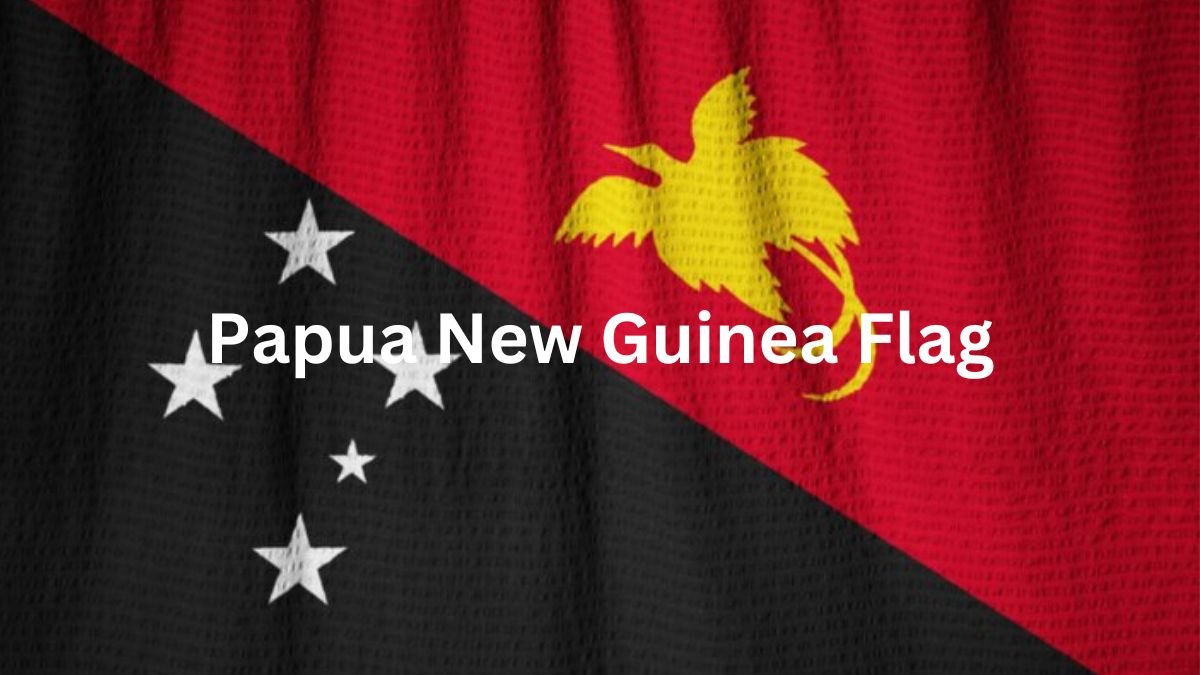The Papua New Guinea Flag is a vibrant symbol of the nation, encapsulating its rich history, cultural diversity, and natural beauty. Each element and color on the flag carries deep significance, reflecting the identity and heritage of the people
History of the Papua New’Guinea Flag
Design Elements of the Flag
The flag features a diagonal bicolor design, divided into two triangles. The upper triangle is red with a yellow silhouette of the Raggiana Bird of Paradise, while the lower triangle is black with the Southern Cross constellation depicted in white. This unique layout combines traditional symbols with modern design, creating a flag that is both visually striking and deeply meaningful.
The Colors of the Papua New Guinea Flag
The colors of Papua’New Guinea Flag are black, red, and yellow. Each color is carefully chosen to represent different aspects of the nation’s identity, from its cultural heritage to its natural environment.
Meaning and Symbolism of Black
Black is a prominent color on the flag, symbolizing the indigenous people of Papua New Guinea. It represents the strength, resilience, and unity of the various ethnic groups that make up the nation. The color black is a unifying force, acknowledging the shared identity and collective history of the people.
Cultural Significance of Blacks in Papua’New Guinea
In Papua New Guinea, black is also associated with the earth and the land, which are central to the lives and traditions of the people. The land is revered and respected, seen as a source of sustenance and spiritual connection. Thus, black on the flag honors the deep relationship between the people and their homeland.
Red in the Flag
Meaning and Symbolism of Red
Red is a powerful and dynamic color on the Papua’New Guinea flag, symbolizing the vitality and bravery of the nation’s people. It reflects the strength and courage required to achieve independence and build a new nation. Red also stands for the bloodshed during the struggle for freedom, a reminder of the sacrifices made by previous generations.
Cultural Significance of Red in Papua New Guinea
In many cultures within Papua New Guinea, red is associated with celebration and joy. It is often used in traditional ceremonies and festivals, signifying life and prosperity. By incorporating red into the flag, it highlights the vibrant cultural heritage and the joyous spirit of the people.
Yellow in the Flag
Meaning and Symbolism of Yellow
Yellow on the flag represents the wealth and natural resources of Papua’New Guinea, particularly gold. Gold has historically been a significant part of the nation’s economy and cultural exchanges. Yellow also symbolizes the sun, a source of life and energy, reflecting the bright and optimistic future of the nation.
Cultural Significance of Yellow in Papua New Guinea
It is a color that signifies enlightenment and guidance, which is essential in many traditional practices and beliefs. By featuring yellow on the flag, it underscores the spiritual richness and the guiding principles of the nation.
The Southern Cross
Description and Meaning of the Southern Cross
The Southern Cross constellation is depicted in white on the black triangle of the flag. This constellation is an important navigational symbol, historically used by sailors to guide their way. The flag represents the country’s geographical location in the Southern Hemisphere and its connection to the wider world.
Historical and Cultural Significance of the Southern Cross
The Southern Cross has been a significant symbol in the region for centuries, used by indigenous navigators long before European exploration. Its presence on the flag honors this ancient knowledge and the navigational skills of the ancestors, linking the past with the present.
The Raggiana Bird of Paradise
Description and Significance of the Bird
The Raggiana Bird of Paradise, depicted in yellow on the red triangle, is the national bird of Papua New Guinea. This bird is renowned for its stunning plumage and elaborate courtship displays, symbolizing beauty, elegance, and the rich biodiversity of the nation.
Importance of the Bird in Papua New Guinea Culture
The Bird of Paradise holds a special place in the cultural traditions of Papua New Guinea. By including the Bird of Paradise on the flag, it celebrates the unique wildlife of the country and the cultural significance of this majestic bird.
Symbolism in Combination
How the Colors and Symbols Work Together
The combination of colors and symbols on the Papua’New Guinea Flag creates a cohesive narrative about the nation. Black and red ground the flag in the cultural and historical realities, while yellow and the Bird of Paradise elevate it with themes of wealth, beauty, and spirituality. The Southern Cross ties the nation to its place in the world, guiding its people toward a united and prosperous future.
The Overall Message of the Flag
Together, these elements communicate a powerful message of unity, resilience, and pride. The flag is a testament to the rich cultural tapestry and natural wonders of Papua’New Guinea, celebrating its past while looking forward to a bright and hopeful future.
Cultural Impact of the Flag
How the Flag is Perceived by the People
The Papua’New Guinea Flag is a source of immense pride for its citizens. It is a symbol of national identity and unity, representing the diverse cultures and traditions that make up the country.
The Flag in National Celebrations and Identity
From Independence Day celebrations to international sporting events, the flag plays a central role in national life. It is a unifying emblem that brings people together, reminding them of their shared history and common goals.
Comparisons with Other Flags
Similarities with Other National Flags
The Papua’New Guinea Flag shares some similarities with other national flags, particularly in its use of the Southern Cross, which is also featured on the flags of Australia and New Zealand. However, the unique combination of colors and the inclusion of the Bird of Paradise set it apart, making it distinctively Papua New Guinean.
Unique Aspects of the Papua’New Guinea Flag
What truly makes the Papua’New Guinea Flag unique is its deep cultural symbolism and the story behind its design. Unlike many flags that follow more conventional patterns, the Papua’New Guinea Flag is a bold representation of the nation’s identity, rich in meaning and heritage.
Modern Interpretations and Uses
The Flag in Contemporary Culture and Politics
In contemporary Papua’New Guinea, the flag continues to be a powerful symbol. It is used in political contexts to represent national unity and sovereignty and in cultural expressions such as art, music, and literature, where it inspires and unites.
Use of the Flag in Art and Media
Artists and designers in Papua’New Guinea often incorporate the flag into their work, using its colors and symbols to convey messages of pride and resilience. The flag is also a common sight in media, from television broadcasts to online platforms, reinforcing its status as a national icon.
Controversies and Discussions
Debates Around the Flag’s Design
Some discussions focus on whether it adequately represents all regions and cultures within the country. However, these debates are part of a healthy dialogue about national identity and inclusiveness.
Discussions on Potential Changes or Updates
From time to time, there are proposals to update or modify the flag to reflect contemporary realities. These discussions are important as they ensure that the flag remains relevant and continues to resonate with the people of Papua’New Guinea.
Conclusion
The flag of Papua’New Guinea is more than just a national symbol; it is a vibrant tapestry of the nation’s history, culture, and natural beauty. Each color and symbol on the flag tells a story, celebrating the resilience, diversity, and unity of the Papua New Guinean people. As the nation continues to grow and evolve, the flag remains a powerful reminder of its rich heritage and bright future.
FAQs
What is the meaning behind the colors of the Papua’New Guinea flag?
The colors black, red, and yellow on the Papua’New Guinea Flag represent the indigenous people, vitality and bravery, and the wealth and natural resources of the nation, respectively.
When was the Papua’New Guinea Flag adopted?
The Papua’New Guinea Flag was officially adopted on July 1, 1971.
What does the bird on the Papua New’Guinea flag represent?
The bird on the flag is the Raggiana Bird of Paradise, symbolizing the nation’s beauty, elegance, and rich biodiversity.
Why is the Southern Cross on the Papua’New Guinea flag?
The Southern Cross represents the country’s geographical location in the Southern Hemisphere and its historical significance as a navigational aid.





